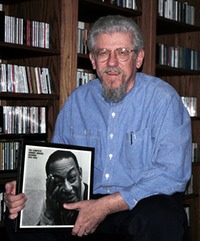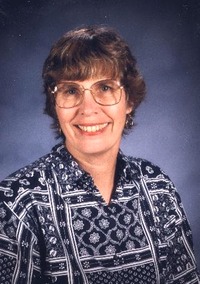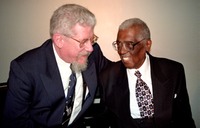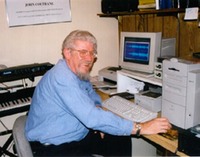I was born in 1943 in California. My late wife Rosa and I were married for nearly 45 years. Rosa was a high school librarian at Affton High School. We have two grown children. Dan is a network architect for IBM. Anna is an athletic trainer with a B.S. and M.S. in kineseology from Indiana University. She works with dancers and other performing artists and currently works for St. Vincent's Sports Medicine Clinic in Indianapolis, Brebuf Jesuit High School, the Butler Univrsity Dance Program and Dance Kaleidoscope. Professionally I have a Ph.D. in organic chemistry and was a scientist at Monsanto (1960-1996) and a college and university chemistry teacher (1978-1983) and 1996-2002).
I have been interested in jazz since I was about 15 and have been a student of this music since that time. I became obsessed early and began collecting records around 1959. Some of my memories of that time are hiding the good stuff in the "Country and Western" bins until I could get the money together to buy it. Several friends in St. Louis told me the same story. In the late 1950's and early 1960's, Los Angeles was a place where you could hear some great music. I was able to hear in live performance just about all the giants who was still alive around that time: Miles Davis, John Coltrane, Cannonball Adderley, Coleman Hawkins, Ben Webster, Bill Evans, Benny Carter, Wes Montgomery, Ornette Coleman, Charles Mingus, Rahsaan Roland Kirk, Thelonious Monk, a very young Bobby Hutcherson and many others too numerous to mention. The crowd I hung with went to coffeehouses and jazz clubs rather than other, less positive teenage hangouts. I became a student of this music very early, when I read Marshall Stearns' book on jazz history. My search for this music went both forward in the present and backward to the earliest music. The important thing is: like all great art, the really great music in this form is timeless.
We moved to St. Louis in 1969. Around 1975, I met Charlie Menees, a St. Louis radio personality and jazz historian who began to fill in some gaps in my knowledge about jazz in the Midwest. This was before the glut of reissues of classic jazz recordings, so Charlie filled in the gaps in my listening with things I had only read about. I met a number of others who, like me, were interested seriously in the history of the music. I was the maverick in the group, however, in that I was never afraid to listen to the avant garde music of the 1960's. I even gave a lecture on avant garde saxophonists for Charlie. The lecture started with an excerpt of the most extreme portions of Flip Phillips' Jazz at the Philharmonic solo on "Perdido." The audience recoiled in horror at that music until I identified the soloist's name. This taught me that we can become conditioned to expect things in our listening. I never could understand why people would wildly applaud the white saxophonists in Woody Herman's 1970's band (who all sounded like Coltrane), but wouldn't cross the street to hear the originator of that style.
I eventually began my radio career with Romondo Davis, who took over Charlie Menees' show on KWMU. He asked me to bring some modern things to the show. I found that I enjoyed it. When Romondo left, Jim Wallace took over the show. He asked me to continue guest producing until April, 1983. I took over the production of Jazz Spectrum at that point and co-hosted it with Jim. On my recommendation, Walter Parker came to KWMU in 1985 to produce and host Jazzstream, a show featuring traditional and mainstream jazz. I moved to Sunday nights with Bebop and Beyond in 1985. The Jazz Unlimited format started in 1988. All shows are now pre-recorded to avoid the occasional glitches and embarrassments.
Charlie Menees taught a class on St. Louis jazz history that led me to do a lot of research into the subject. We obtained a grant for the research. This led to a documentary on St. Louis jazz that ran for 18 hours of air time in 1987. During this research, I met Mr. Eddie Randle, Sr. Eddie, without doubt, was one of the major influences on my life. He was probably the wisest person I have ever known. Eddie was a former bandleader who had a band called the St. Louis Blue Devils. Ernie Wilkins, Miles Davis and Oliver Nelson are just three of the people who passed through his band. Until his death in 1997, he was a funeral director. We hit it off immediately and spent a lot of time together over the next 10 years. When Miles Davis died, one of the TV stations called me to do an interview. I told them that I wouldn't do it unless Eddie was included. A few days later, Eddie called me and asked me if I would accompany him to the memorial service for Miles in East St. Louis. When I went to pick him up, he informed me that he would be speaking and that I was to accompany him to the rostrum to speak also. I nearly went home right there, but finally he convinced me that I had something to say. This was an example of his version of the "Golden Rule." It went like this: "When someone does something to you, get them back. But get them back only if it was a good thing. If it was a bad thing, getting them back lowers you to their level."
In 1988, I began fooling around with synthesizers. With these things, you can be a one person band and I compose, arrange and improvise things for fun. I have done arrangements on a number of famous jazz tunes. Some of these arrangements probably have their composers spinning in their graves. I began my study of Ellington's scores using synthesizers and discovered just how "out" Duke was. From early times, he was hiding some of the most incredible dissonances in his scores. Eventually, I taught a class on Ellington's music that was followed by a concert. For that concert, I used the synthesizers to cut down big band arrangements of "East St. Louis Toodle-O," "KoKo" and "Blue Light" for a septet. The rearrangements must have worked, because the musicians enjoyed playing them. In 2006, to celebrate the publishing of my book "City of Gabriels-The Jazz History of St. Louis 1895-1973" and the concurrent opening of an exhibit on the jazz history of St. Louis in September 2006 at the Sheldon Art Gallery, I put together a concert of important jazz music from the period 1898 to 1973. The concert got two standing ovations.
I am also interested in photography. With the acquisition of a digital slide and film scanner (and now digital cameras) I can now present photos of musicians in performance from my files going back to 1972. These are found un the Photo Gallery on this website. They were exhibited at the Sheldon Art Gallery in 1992 in a show called "Festival Jazz!" I had my own exhibit in 2005-6 at the Sheldon called "In the Moment--Jazz Musicians in Performance." My photographs have been shown on web sites around the world (mostly with my permission, but some have been stolen), on album covers and in music textbooks. Keep listening!




